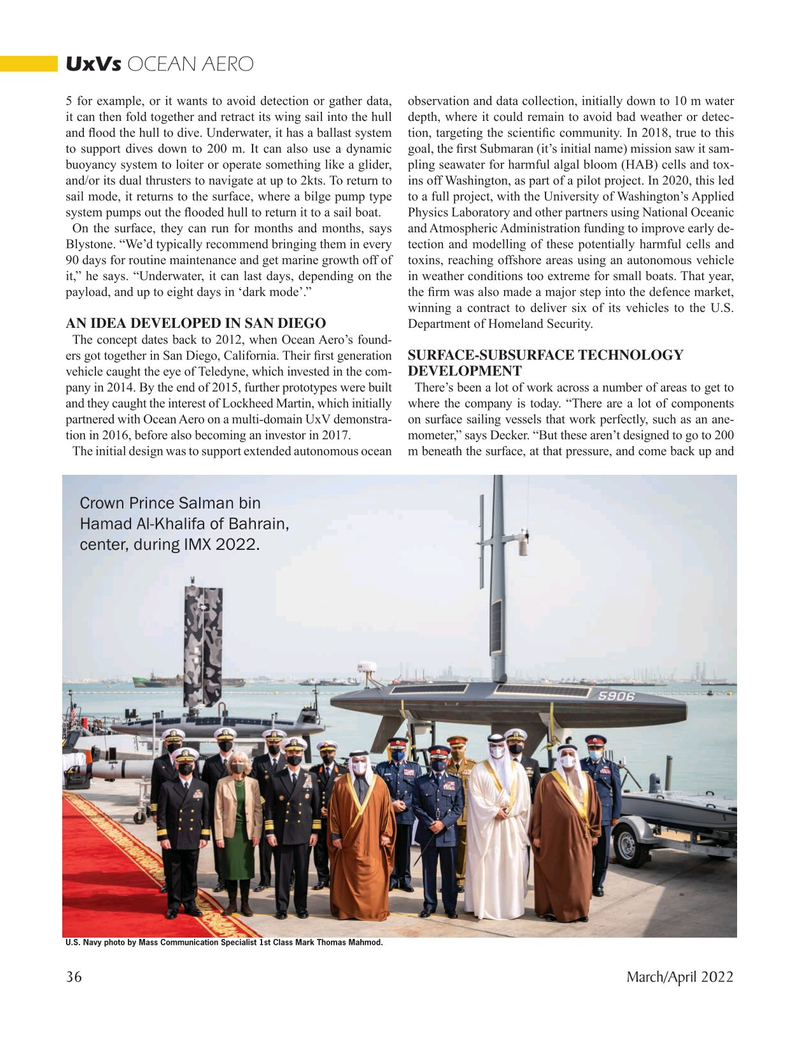
Page 36: of Marine Technology Magazine (March 2022)
Read this page in Pdf, Flash or Html5 edition of March 2022 Marine Technology Magazine
UxVs OCEAN AERO 5 for example, or it wants to avoid detection or gather data, observation and data collection, initially down to 10 m water it can then fold together and retract its wing sail into the hull depth, where it could remain to avoid bad weather or detec- and ? ood the hull to dive. Underwater, it has a ballast system tion, targeting the scienti? c community. In 2018, true to this to support dives down to 200 m. It can also use a dynamic goal, the ? rst Submaran (it’s initial name) mission saw it sam- buoyancy system to loiter or operate something like a glider, pling seawater for harmful algal bloom (HAB) cells and tox- and/or its dual thrusters to navigate at up to 2kts. To return to ins off Washington, as part of a pilot project. In 2020, this led sail mode, it returns to the surface, where a bilge pump type to a full project, with the University of Washington’s Applied system pumps out the ? ooded hull to return it to a sail boat. Physics Laboratory and other partners using National Oceanic
On the surface, they can run for months and months, says and Atmospheric Administration funding to improve early de-
Blystone. “We’d typically recommend bringing them in every tection and modelling of these potentially harmful cells and 90 days for routine maintenance and get marine growth off of toxins, reaching offshore areas using an autonomous vehicle it,” he says. “Underwater, it can last days, depending on the in weather conditions too extreme for small boats. That year, payload, and up to eight days in ‘dark mode’.” the ? rm was also made a major step into the defence market, winning a contract to deliver six of its vehicles to the U.S.
AN IDEA DEVELOPED IN SAN DIEGO Department of Homeland Security.
The concept dates back to 2012, when Ocean Aero’s found- ers got together in San Diego, California. Their ? rst generation SURFACE-SUBSURFACE TECHNOLOGY vehicle caught the eye of Teledyne, which invested in the com-
DEVELOPMENT pany in 2014. By the end of 2015, further prototypes were built There’s been a lot of work across a number of areas to get to and they caught the interest of Lockheed Martin, which initially where the company is today. “There are a lot of components partnered with Ocean Aero on a multi-domain UxV demonstra- on surface sailing vessels that work perfectly, such as an ane- tion in 2016, before also becoming an investor in 2017. mometer,” says Decker. “But these aren’t designed to go to 200
The initial design was to support extended autonomous ocean m beneath the surface, at that pressure, and come back up and
Crown Prince Salman bin
Hamad Al-Khalifa of Bahrain, center, during IMX 2022.
U.S. Navy photo by Mass Communication Specialist 1st Class Mark Thomas Mahmod.
36 March/April 2022
MTR #3 (34-49).indd 36 2/25/2022 10:07:38 AM

 35
35

 37
37
